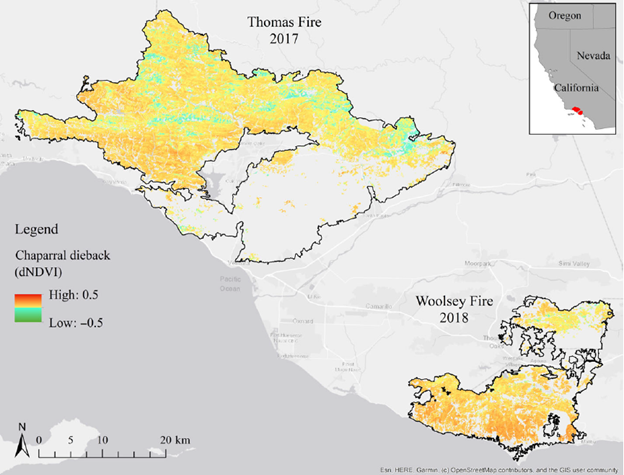California recently experienced one of the most severe droughts in its history, resulting in extensive dieback of chaparral vegetation in the State’s Mediterranean regions. Though chaparral species are adapted to annual summer drought, the duration or intensity of a drought may exceed the adaptive capabilities of even these plants. The impacts of the recent severe drought were further exacerbated in many chaparral ecosystems by the occurrence of wildfires. The most infamous of these fires in southern California were the 2017 Thomas Fire and the 2018 Woolsey Fire.
USGS researchers are using remote sensing data to detect and verify vegetation dieback in southern California shrubland landscapes and then determine whether there is a relationship between dieback and patterns of fire severity in the Woolsey and Thomas fires. Specific research goals of the project include 1) mapping the spatial extent of chaparral dieback within the perimeters of the Thomas and Woolsey fires prior to their respective burns by calculating the difference in annual NDVI (Normalized Difference Vegetation Index) between the year prior to the drought and six years after, 2) assessing the effects of potential drivers causing dieback of chaparral vegetation, and 3) evaluating the effect of vegetation dieback on the patterns of burn severity within the Thomas and Woolsey Fires using Monitoring Trends in Burn Severity differenced Normalized Burn Ratio (dNBR) data.
These fires serve as a test of the usefulness of this approach for evaluating relationships between severe drought, vegetation dieback, and subsequent fire severity, and for determining the extent to which that information could inform land and fire management activities in the region.
https://doi.org/10.1002/ecs2.4203

Chaparral dieback within the 2017 Thomas Fire and 2018 Woolsey Fire perimeters in California, calculated as the difference in mean annual normalized difference vegetation index (NDVI) between 2010 and 2016. Positive values indicate a decrease in live vegetation.

